The Search for the Biological Basis of Memory
KEY THEME
Early researchers believed that memory was associated with physical changes in the brain, but these changes were discovered only in the past few decades.
KEY QUESTIONS
How are memories both localized and distributed in the brain?
How do neurons change when a memory is formed?
Does the name Ivan Pavlov ring a bell? We hope so. As you should recall from Chapter 5, Pavlov was the Russian physiologist who classically conditioned dogs to salivate to the sound of a bell and other neutral stimuli. Without question, learning and memory are intimately connected. Learning an adaptive response depends on our ability to form new memories in which we associate environmental stimuli, behaviors, and consequences.
Pavlov (1927) believed that the memory involved in learning a classically conditioned response would ultimately be explained as a matter of changes in the brain. However, Pavlov only speculated about the kinds of brain changes that would produce the memories needed for classical conditioning to occur. Other researchers would take up the search for the physical changes associated with learning and memory. In this section, we look at some of the key discoveries that have been made in trying to understand the biological basis of memory.
The Search for the Elusive Memory Trace
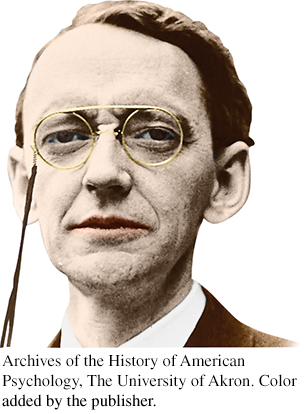
An American physiological psychologist named Karl Lashley set out to find evidence for Pavlov’s speculations. In the 1920s, Lashley began the search for the memory trace, or engram—the brain changes that were presumed to occur in forming a long-
Lashley searched for the specific location of the memory trace that a rat forms for running a maze. Lashley (1929) suspected that the specific memory was localized at a specific site in the cerebral cortex, the outermost covering of the brain that contains the most sophisticated brain areas. Once a rat had learned to run the maze, Lashley surgically removed tiny portions of the rat’s cortex. After the rat recovered, Lashley tested the rat in the maze again. Obviously, if the rat could still run the maze, then the portion of the brain removed did not contain the memory.
Over the course of 30 years, Lashley systematically removed different sections of the cortex in trained rats. The result of Lashley’s painstaking research? No matter which part of the cortex he removed, the rats were still able to run the maze (Lashley, 1929, 1950). At the end of his professional career, Karl Lashley concluded that memories are not localized in specific locations but instead are distributed, or stored, throughout the brain.
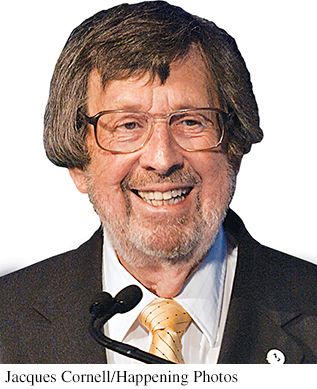
Lashley was wrong, but not completely wrong. Some memories do seem to be localized at specific spots in the brain. Some 20 years after Lashley’s death, psychologist Richard F. Thompson and his colleagues resumed the search for the location of the memory trace that would confirm Pavlov’s speculations.
Thompson classically conditioned rabbits to perform a very simple behavior—
Thompson discovered that after a rabbit had learned this simple behavior, there was a change in the brain activity in a small area of the rabbit’s cerebellum, a lower brain structure involved in physical movements. When this tiny area of the cerebellum was removed, the rabbit’s memory of the learned response disappeared. It no longer blinked at the sound of the tone. However, the puff of air still caused the rabbit to blink reflexively, so the reflex itself had not been destroyed.
Thompson and his colleagues had confirmed Pavlov’s speculations. The long-
So why had Karl Lashley failed? Unlike Thompson, Lashley was working with a relatively complex behavior. Running a maze involves the use of several senses, including vision, smell, and touch. In contrast, Thompson’s rabbits had learned a very simple reflexive behavior—
Thus, part of the reason Lashley failed to find a specific location for a rat’s memory of a maze was that the memory was not a single memory. Instead, the rat had developed a complex set of interrelated memories involving information from multiple senses. These interrelated memories were processed and stored in different brain areas. As a result, the rat’s memories were distributed and stored across multiple brain locations. Hence, no matter which small brain area Lashley removed, the rat could still run the maze. So Lashley was right in suggesting that some memories are distributed throughout the brain.
Combined, the findings of Lashley and Thompson indicate that memories have the potential to be both localized and distributed. Very simple memories may be localized in a specific area, whereas more complex memories are distributed throughout the brain. A complex memory involves clusters of information, and each part of the memory may be stored in the brain area that originally processed the information (Greenberg & Rubin, 2003).
MYTH SCIENCE
Is it true that all memories, even complex ones, are located in a single part of the brain?
Adding support to Lashley’s and Thompson’s findings, brain imaging technology has confirmed that many kinds of memories are distributed in the human brain. When we are performing a relatively complex memory task, multiple brain regions are activated—
The Focus on Neuroscience on the next page describes a clever study that looked at how memories involving different sensory experiences are assembled when they are retrieved.
The Role of Neurons in Long-Term Memory
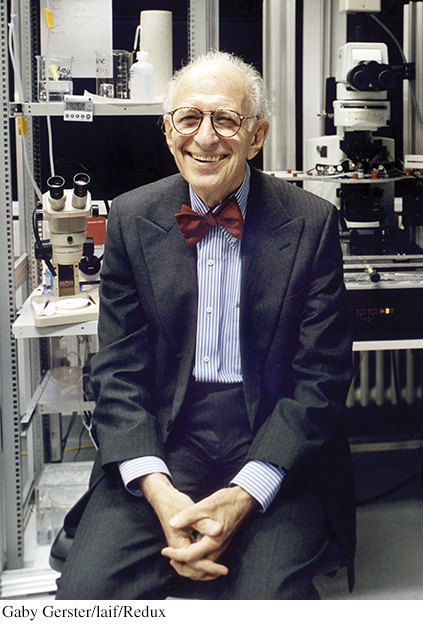
What exactly is it that is localized or distributed? The notion of a memory trace suggests that some change must occur in the workings of the brain when a new long-
Enter Aplysia, a gentle, seaweed-

FOCUS ON NEUROSCIENCE
Assembling Memories: Echoes and Reflections of Perception
If we asked you to remember the theme from Sesame Street, you would “hear” the song in your head. Conjure up a memory of your high school cafeteria, and you “see” it in your mind. Memories can include a great deal of sensory information—
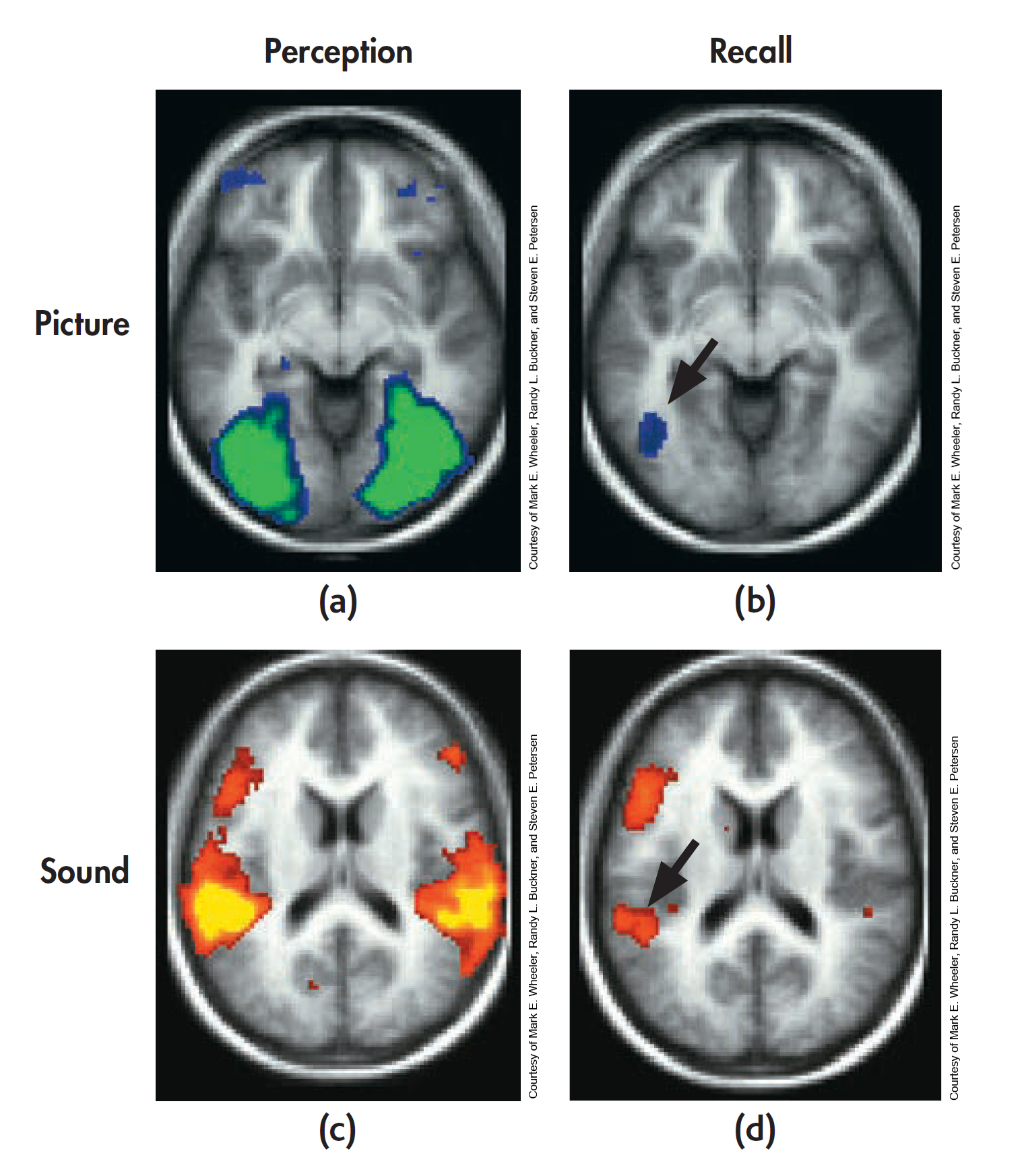
Researchers set out to investigate this question using a simple memory task and fMRI (Wheeler & others, 2000).Participants studied names for common objects that were paired with either a picture or a sound associated with the word. For example, the word “dog” was either paired with a picture of a dog or the sound of a dog barking. The researchers then used fMRI to measure brain activity when the volunteers were instructed to recall the words they’d memorized.
The results? Retrieving the memory activated a subset of the same brain areas that were involved in perceiving the sensory stimulus. Participants who had memorized the word dog with a picture of a dog showed a high level of activation in the visual cortex when they retrieved the memory. And participants who had memorized the word dog with the sound of a barking dog showed a high level of activation in the auditory cortex when they retrieved the memory.
Of course, many of our memories are highly complex, involving not just sensations but also thoughts and emotions. Neuroscientists assume that such complex memories involve traces that are widely distributed throughout the brain. However, they still don’t understand how all these neural records are bound together and interrelated to form a single, highly elaborate memory (Khan & Muly, 2011).
If you give Aplysia a gentle squirt with a WaterPik, followed by a mild electric shock to its tail, the snail reflexively withdraws its gill flap. When the process is repeated several times, Aplysia wises up and acquires a new memory of a classically conditioned response—
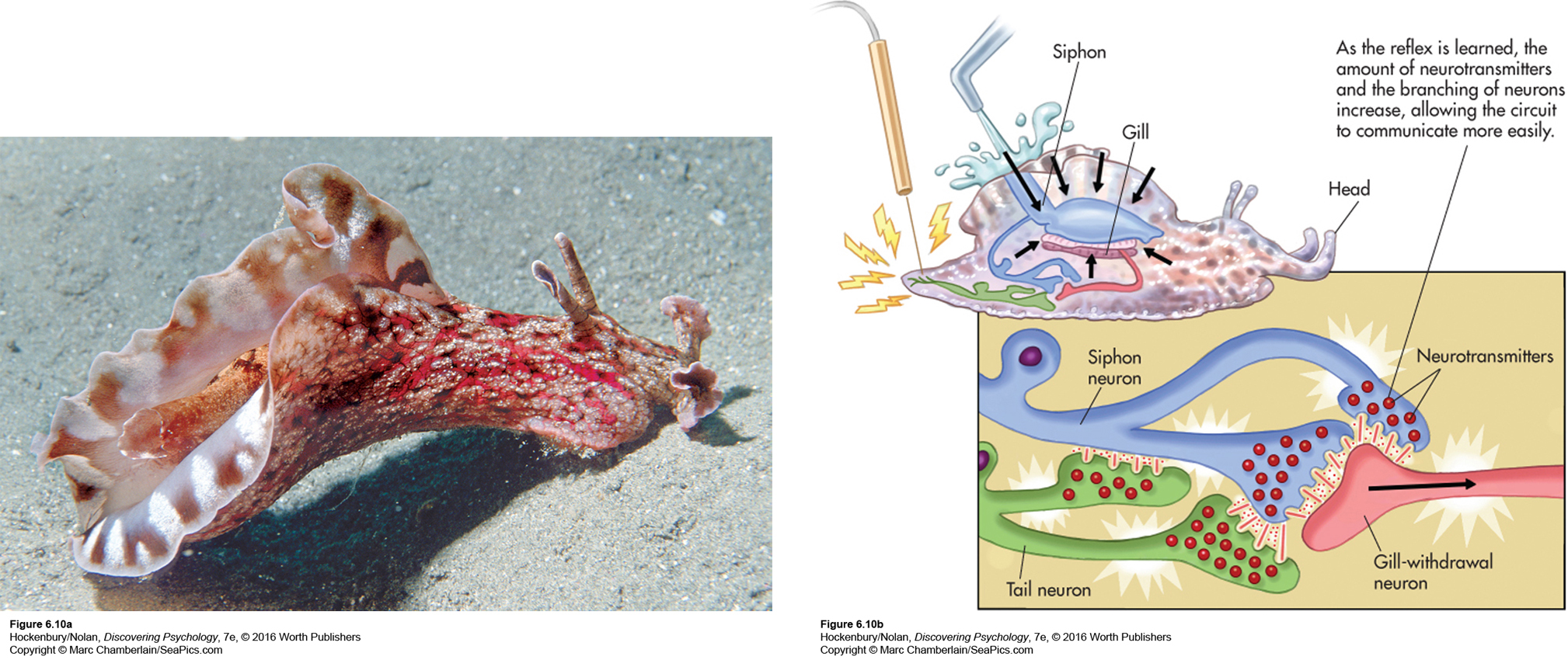
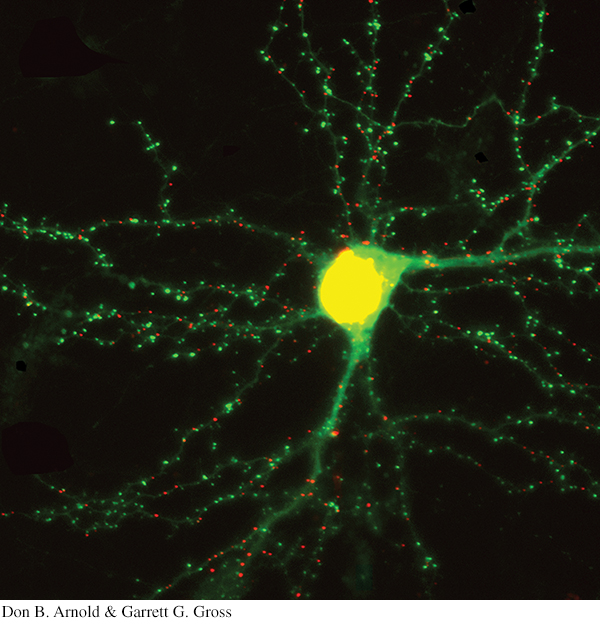
When Aplysia acquires this new memory through repeated training trials, significant changes occur in the three-
The same kinds of brain changes have been observed in more sophisticated mammals. Chicks, rats, and rabbits also show structural and functional neuron changes associated with new learning experiences and memories. And, as you may recall from Psych for Your Life in Chapter 2, there is ample evidence that the same kinds of changes occur in the human brain.
In terms of our understanding of the memory trace, what do these findings suggest? Although there are vast differences between the nervous system of a simple creature such as Aplysia and the enormously complex human brain, some tentative generalizations are possible. Forming a memory seems to produce distinct functional and structural changes in specific neurons. These changes create a memory circuit. Each time the memory is recalled, the neurons in this circuit are activated. As the structural and functional changes in the neurons strengthen the communication links in this circuit, the memory becomes established as a long-
Processing Memories in the Brain
CLUES FROM AMNESIA
KEY THEME
Important insights into the brain structures involved in normal memory have been provided by case studies of people with amnesia caused by damaged brain tissue.
KEY QUESTIONS
Who was H.M. and what did his case reveal about normal memory processes?
What brain structures are involved in normal memory?
What are dementia and Alzheimer’s disease?
Prior to the advent of today’s sophisticated brain imaging technology, researchers studied individuals who had sustained a brain injury or had part of their brain surgically removed for medical reasons. Often, such individuals experienced amnesia, or severe memory loss. By relating the type and extent of amnesia to the specific damaged brain areas, researchers uncovered clues as to how the human brain processes memories.
RETROGRADE AMNESIA
DISRUPTING MEMORY CONSOLIDATION
One type of amnesia is retrograde amnesia. Retrograde means “backward moving.” People who have retrograde amnesia are unable to remember some or all of their past, especially episodic memories for recent events. Retrograde amnesia often results from a blow to the head. Boxers sometimes suffer such memory losses after years of fighting. Head injuries from automobile and motorcycle accidents are another common cause of retrograde amnesia. Typically, memories of the events that immediately preceded the injury are completely lost, as in the case of accident victims who cannot remember details about what led up to the accident.
Apparently, establishing a long-
In humans, memory consolidation can be disrupted by brain trauma, such as a sudden blow, concussion, electric shock, or encephalitis (Riccio & others, 2003). Similarly, many drugs, such as alcohol and the benzodiazepines, interfere with memory consolidation. In contrast, stimulants and the stress hormones that are released during emotional arousal tend to enhance memory consolidation (Nielson & Lorber, 2009).

ANTEROGRADE AMNESIA
DISRUPTING THE FORMATION OF EXPLICIT MEMORIES
Another form of amnesia is anterograde amnesia—the inability to form new memories. Anterograde means “forward moving.” The most famous case study of anterograde amnesia lasted over 50 years. It was of a man who for years was known only by his initials—
In 1953, Henry was 27 years old and had a 10-
After the experimental surgery, the frequency and severity of Henry’s seizures were greatly reduced. However, it was quickly discovered that Henry’s ability to form new memories of events and information had been destroyed. Although the experimental surgery had treated H.M.’s seizures, it also dramatically revealed the role of the hippocampus in forming new explicit memories for episodic and semantic information.
Psychologists Brenda Milner (1970) and Suzanne Corkin (2013) studied Henry extensively over the past 50 years. If you had had the chance to meet Henry, he would have appeared normal enough. He had a good vocabulary and social skills, normal intelligence, and a delightful sense of humor. And he was well aware of his memory problem. When Suzanne Corkin (2002) once asked him, “What do you do to try to remember?” Henry quipped, “Well, that I don’t know because I don’t remember [chuckle] what I tried.”

Because of the profound anterograde amnesia caused by the surgery, Henry became one of the most intensive case studies in psychology and neuroscience. Over the next half century, Henry participated in hundreds of studies that fundamentally altered the scientific understanding of memory.
Henry died on December 2, 2008, but his contributions to science continue. Neuroscientist Jacopo Annese and his team (2014) dissected Henry’s brain, slicing it into 2,400 micro-
Despite superficially appearing normal, Henry lived in the eternal present. Had you talked with Henry for 15 minutes, then left the room for 2 or 3 minutes before coming back, he wouldn’t remember having met you before. Although some of the psychologists and doctors had treated Henry for years, even decades, Henry was meeting them for the first time on each occasion he interacted with them (Corkin, 2013; MacKay, 2014).

For the most part, Henry’s short-
In general, Henry was unable to acquire new long-
Henry’s case suggests that the hippocampus is not involved in most short-
Implicit and Explicit Memory in Anterograde Amnesia Henry’s case and those of other patients with anterograde amnesia have contributed greatly to our understanding of implicit versus explicit memories. To refresh your memory, implicit memories are memories without conscious awareness. In contrast, explicit memories are memories with conscious awareness.
Henry could not form new episodic or semantic memories, which reflects the explicit memory system. But he could form new procedural memories, which reflects the implicit memory system. For example, when given the same logical puzzle to solve several days in a row, Henry was able to solve it more quickly each day. This improvement showed that he implicitly “remembered” the procedure involved in solving the puzzle. But if you asked Henry if he had ever seen the puzzle before, he would answer “no” because he could not consciously (or explicitly) remember having learned how to solve the puzzle. This suggests that the hippocampus is less crucial to the formation of new implicit memories, such as procedural memories, than it is to the formation of new explicit memories.
Were Henry’s memory anomalies an exception? Not at all. Studies conducted with other people who have sustained damage to the hippocampus and related brain structures showed the same anterograde amnesia (see Bayley & Squire, 2002). Like Henry, these patients are unable to form new explicit memories, but their performances on implicit memory tasks, which do not require conscious recollection of the new information, are much closer to normal. Such findings indicate that implicit and explicit memory processes involve different brain structures and pathways.
BRAIN STRUCTURES INVOLVED IN MEMORY
Along with the hippocampus, several other brain regions involved in memory include the cerebellum, the amygdala, and the frontal cortex (see Figure 6.11). As you saw earlier, the cerebellum is involved in classically conditioning simple reflexes, such as the eye-
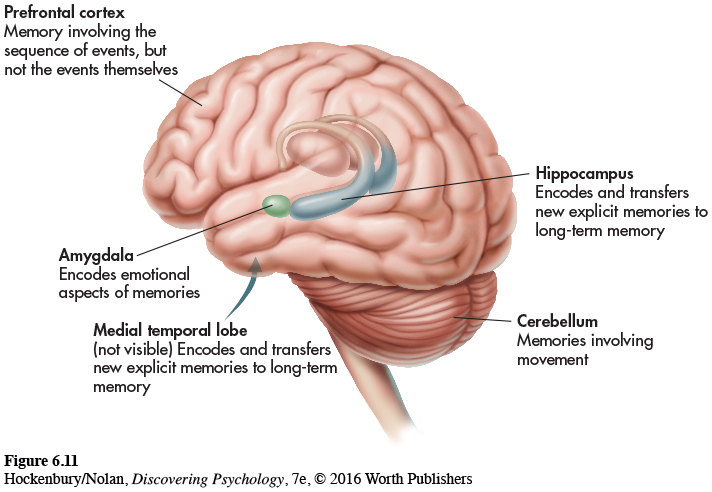
The amygdala, which is situated very close to the hippocampus, is involved in encoding and storing the emotional qualities associated with particular memories, such as fear or anger (Hamann, 2009; McGaugh, 2004). For example, normal monkeys are afraid of snakes. But if the amygdala is damaged, a monkey loses its fear of snakes and other natural predators.
The frontal lobes are involved in retrieving and organizing information that is associated with autobiographical and episodic memories (Greenberg & Rubin, 2003). The prefrontal cortex seems to play an important role in working memory (D’Esposito & Postle, 2015; McNab & Klingberg, 2008).
The medial temporal lobes, like the frontal lobes, do not actually store the information that comprises our autobiographical memories. Rather, they are involved in encoding complex memories, by forming links among the information stored in multiple brain regions (Greenberg & Rubin, 2003; Shrager & Squire, 2009). As we described in the Focus on Neuroscience, “Assembling Memories,” on page 258, retrieving a memory activates the same brain regions that were involved in initially encoding the memory.
ALZHEIMER’S DISEASE
GRADUALLY LOSING THE ABILITY TO REMEMBER
Understanding how the brain processes and stores memories has important implications. Dementia is a broad term that refers to the decline and impairment of memory, reasoning, language, and other cognitive functions. These cognitive disruptions occur to such an extent that they interfere with the person’s ability to carry out daily activities. Dementia is not a disease itself. Rather, it describes a group of symptoms that often accompany a disease or a condition.
The most common cause of dementia is Alzheimer’s disease (AD). It is estimated that about 5.4 million Americans suffer from AD. That number is expected to dramatically escalate as more and more “baby boomers” reach age 65. The disease usually doesn’t begin until after age 60, but the risk goes up with age. About 6 percent of men and women in the 65–

For example, the outward signs of Alzheimer’s disease (AD) and the degree of brain damage evident at death are not perfectly correlated. Although some nuns had clear brain evidence of AD, they did not display observable cognitive and behavior declines prior to their deaths. Other nuns had only mild brain evidence of AD but showed severe cognitive and behavioral declines.
Interestingly, the sisters who displayed better language abilities when they were young women were less likely to display AD symptoms. This held true regardless of how much brain damage was evident at the time of their death (Iacono & others, 2009). As researcher Diego Iacono (2009) commented, “It’s the first time that we’re shown that a complex cognitive activity, like language ability, is connected with a neurodegenerative disease.”

FOCUS ON NEUROSCIENCE
Mapping Brain Changes in Alzheimer’s Disease
The hallmark of Alzheimer’s disease is its relentless, progressive destruction of neurons in the brain, turning once-

Thompson likens the progression of AD to that of molten lava flowing around rocks—
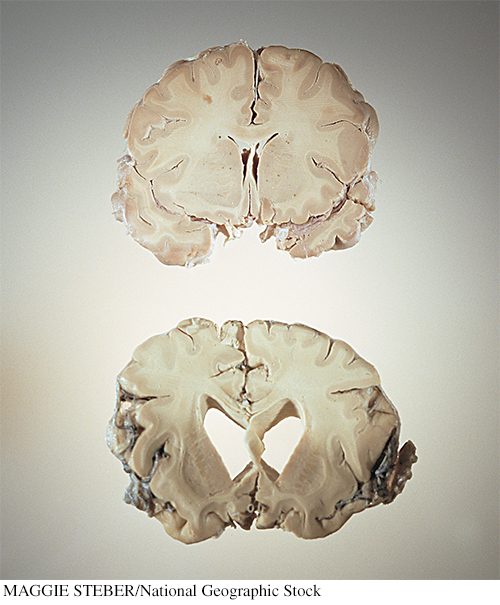
Although the cause or causes of Alzheimer’s disease are still unknown, it is known that the brains of AD patients develop an abundance of two abnormal structures—
In the early stages of AD, the symptoms of memory impairment are often mild, such as forgetting the names of familiar people, forgetting the location of familiar places, or forgetting to do things. But as the disease progresses, memory loss and confusion become more pervasive. The person becomes unable to remember what month it is or the names of family members. Frustrated and disoriented by the inability to retrieve even simple information, the person can become agitated and moody. In the last stage of AD, internal brain damage has become widespread. The person no longer recognizes loved ones and is unable to communicate in any meaningful way. All sense of self and identity has vanished. At the closing stages, the person becomes completely incapacitated. Ultimately, Alzheimer’s disease is fatal (Alzheimer’s Association, 2011).
Some 14.9 million Americans provide unpaid care for a person with Alzheimer’s disease or other dementia. These unpaid caregivers are primarily family members but also include friends and neighbors. In 2010, these caregivers provided 17 billion hours of unpaid care (Alzheimer’s Association, 2011). Not only is there a financial toll, but families and caregivers struggle with great physical and emotional stress as they try to cope with the mental and physical changes occurring in their loved one. The average number of hours of unpaid care provided for a relative or friend with Alzheimer’s increases as the person’s condition worsens.
Numerous resources, such as the Alzheimer’s Disease Education & Referral Center (www.alzheimers.org) and the Alzheimer’s Association (www.alz.org), are available to help support families and other caregivers.
Test your understanding of the Biological Basis of Memory with  .
.